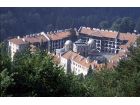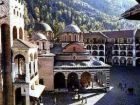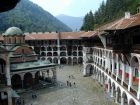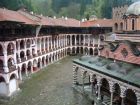Rila monastery
Rila monastery
It was fonded in the X century by Ivan Rilski and used to be the primary spiritual and cultural center of Bulgaria and the whole ortodox enclave.
16 000 volume library including 134 manuscripts from 15th to 19th century.
The introduction to the Rila Monastery could well start with the words of the first Bulgarian historian, Paissii of Hilendar, recorded in 1762 in his Slav-Bulgarian History: "Of all the Bulgarian glory when there were so many large monasteries and churches in Bulgaria earlier the Lord has left only the Rila Monastery to exist in our times... It is of great use to all Bulgarians. Therefore, it is the duty of all Bulgarians to guard it, and to give alms to the sacred Rila Monastery. . ."
The monastery has been destroyed by fire, and abandoned by the monks.
Its presentday place, 119 km south of Sofia , is the one in which it stood during the 14th century, when the protosebast Dragovol Hrelyo settled in the monastery as an independent ruler.
In 1335 he built the five-storey defence tower, topped by the Transfiguration Chapel, fragments of whose murals can still be seen today.
By the end of 14th century, the Rila Monastery had turned into a powerful feudal entity with many villages, lands and properties.
Tsar Shishman alone, the last Bulgarian ruler, donated it over twenty villages in different districts.
The monastery's unquestionable authority influenced the Turkish sultants who confirmed the rights granted by the Bulgarian kings by special firmans.
Irrespective of this, the Monastery was devastated around the mid-15th century.
It started rising again after the relics of Ivan Rilski were brought from Veliko Turnovo here in 1469 (passing through the whole of Bulgaria as a nationwide patriotic procession).
The fate of the Monastery became the concern of the entire Bulgarian nation.
A new centre was needed for the cultural life, which had declined or was transferred abroad.
Many of the time's most outstanding men of letters gradually started gathering in the monasteries.
The first links with Russian monasteries were established.
The church's interior is extremely impressive.
The icons of the main altar were painted by Ivan Obrazopisov from Samokov.
The twenty donors' potraits in the church mark the beginning of Bulgarian secular painting, of realistic portraits.
This gallery of art was enriched by the murals in the churches and chapels outside the monastery.
Thirty six figural scenes, the figures of the Old Testament Kings, apostles martyrs, an exceptionally rich ornamentation of flowers, birds and stylized figures - this, in short, is the subject-matter of the main carved altar of the Holy Virgin Church fashioned by four masters over a period of five years.
Stunningly carved is the entrance gate of the church of Protosebast Hrelyo, preserved today in the monastery's museum of history.
The museum also contains a multitude of gold and silver church plates, collections of coins, weapons, jewelry goldweave materials and embroidery.










